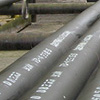

Hunan Standard Steel as a member of Husteel Industry Group, is a professional manufacturer of mild steel pipes and pipe fittings, which has a complete system of production... More
Factory GroupDistribution Mechanism and Hazards of Welded Steel Tube Defects
Date:2017-01-06
Views:2620
Welded steel pipe production process is to steel, steel and other methods of rolling with a variety of methods or in accordance with the direction of spiral bending into the required cross-sectional shape, and then by means of heating, pressurized, with different welding methods of welding To obtain a steel pipe. Therefore, the defects of welded steel pipe is divided into two parts: steel base metal defects and weld defects.
1.Steel base metal defects
Defects in the sheet metal after rolling and other processes, most of the plane-like, parallel with the surface; the main defects are layered, inclusions, cracks, folding, which is the most common layer of internal defects. Delamination will produce a variety of cracks, when the plate is subject to the tensile stress perpendicular to the surface, the stratification will seriously affect the strength of steel, it is not allowed to exist defects.
2.Weld defects
Weld defect is the weld during welding or welding defects in the weld, divided into cracks, pores, slag, not penetration, not fusion, undercut and other weld defects. Welds in the dense pores, slag, etc. are dense three-dimensional defects, cracks, non-fusion is a planar defect, a great harm. Strip-like slag, not penetration and so is a strip defect, harmful. Stomata, small slag and other point-like defects. The defects in the weld more easily lead to the strength of steel, plastic and other issues, seriously affecting the quality of steel pipe, welded pipe quality directly affects the safe operation of oil and gas pipelines and service life, and therefore the main weld detection for welding Cracks in cracks, stomata, slag, not penetration, not melting and other dangerous defects detection.
1.Steel base metal defects
Defects in the sheet metal after rolling and other processes, most of the plane-like, parallel with the surface; the main defects are layered, inclusions, cracks, folding, which is the most common layer of internal defects. Delamination will produce a variety of cracks, when the plate is subject to the tensile stress perpendicular to the surface, the stratification will seriously affect the strength of steel, it is not allowed to exist defects.
2.Weld defects
Weld defect is the weld during welding or welding defects in the weld, divided into cracks, pores, slag, not penetration, not fusion, undercut and other weld defects. Welds in the dense pores, slag, etc. are dense three-dimensional defects, cracks, non-fusion is a planar defect, a great harm. Strip-like slag, not penetration and so is a strip defect, harmful. Stomata, small slag and other point-like defects. The defects in the weld more easily lead to the strength of steel, plastic and other issues, seriously affecting the quality of steel pipe, welded pipe quality directly affects the safe operation of oil and gas pipelines and service life, and therefore the main weld detection for welding Cracks in cracks, stomata, slag, not penetration, not melting and other dangerous defects detection.





















